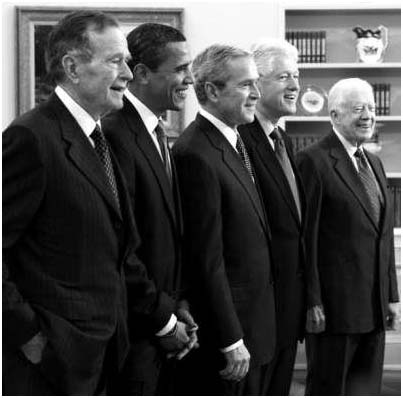

By JANET MASLIN
Published: April 17, 2012
The term “Presidents Club” is used to describe airport lounges that exclude most passengers. It can also designate any group of civic leaders or other association that wants to sound important. It has sometimes been used by American presidents to describe the ties that bind them, but it is not a formal entity. Ex-Presidents Herbert Hoover and Harry S. Truman joked about starting “a former presidents club” when they met at the inauguration of President Eisenhower and wondered what to do with their futures.
But the new book by Nancy Gibbs and Michael Duffy, editors at Time magazine,adopts “The Presidents Club” as both title and catchphrase. It is distractingly shoehorned into the text as often as possible.
“If the Presidents Club had a seal, around the ring would be three words: cooperation, competition and consolation,” they write. If presidents shared Time’s penchant for snappy alliteration, maybe it would.
The book’s overriding idea is good but diffuse: that most presidents share mutual respect, a reverence for their office and a willingness to rise above politics to protect it. In what reads like the longest Time cover article ever written, Ms. Gibbs and Mr. Duffy create a sequence of baton-passing presidential relationships, offer a précis to characterize each neatly, and then cherry-pick the evidence to support the presidents’ various involvements. They also throw in needless nuggets of research, like 1913’s being “a year that produced the zipper, the Federal Reserve and Rosa Parks.”
This reductive writing style turns Hoover and Truman into “two men who by all rights should have loathed each other.” Lyndon B. Johnson and Richard M. Nixon were “two scorpions in a bottle.” Bill Clinton and George W. Bush are “the rascal and the rebel.” Jimmy Carter is just plain trouble, and some of the book’s livelier moments describe his rogue efforts to operate as a one-man State Department, despite the sitting president’s policies and plans.
Any president finds himself in an instant conundrum, and the book zeros in on it. “Presidents typically land in office thinking they know better than their predecessors,” the authors write . “Having just spent an entire campaign convincing voters this is the case, they naturally come to believe it themselves.But then something like a chain reaction occurs: they win the office, then the office strikes back, challenging a president, chastening him, confronting him with all he doesn’t know.” And prompting him quickly to seek the advice of someone who does know what the job of being president actually entails.
Despite the wonderful photo ops provided by presidents confiding in one another, or even showing up en masse, much of presidential counseling is best done in private, or even in secret. A sizable part of the book is devoted to Eisenhower’s discreet but powerful influence: over Truman (who made the mistake of suggesting publicly that the war hero Eisenhower become a presidential candidate); over “that young whippersnapper” John F. Kennedy, who badly needed strategic advice after the Bay of Pigs fiasco; and of course over his own vice president, Nixon.
The book is also sharp in its descriptions of how Nixon ingratiated himself with so many of his successors, particularly Mr. Clinton. When the authors interviewed Mr. Clinton late last year, he spoke reverently about Nixon’s advice on Russia and said he reread a Nixon letter on the subject every year.
“The Presidents Club” tries its best to unfold in an orderly way. But the subject matter can get very tangled, because so many of the presidents’ relationships with one another have spanned decades.
Ronald Reagan shows up ahead of Jimmy Carter, the man he succeeded, because of Reagan’s potential as a presidential candidate in the 1968 election and Nixon’s efforts to stop him. Nixon used a flattering tone with a whiff of condescension: “The Gridiron speech, as you know, is quite a test for the average political figure,” he wrote at an early stage in their elaborate tango. But, as the authors astutely point out, “Seldom has a politician been less qualified to give a rival advice on charming a crowd than Nixon with Reagan.”
Understandably, Ms. Gibbs and Mr. Duffy are more colorful about recent presidencies than about the ones they did not witness. In all cases they draw heavily on memoirs and presidential correspondence. But there are times when, despite the abundance of source material, “The Presidents Club” still manages to be confusing. In describing Nixon’s efforts to get through to Mr. Clinton, the authors describe a March 3, 1993, phone call when Nixon was forced to wait for five minutes, then another eight. Finally Mr. Clinton came to the phone at 10 o’clock. The point is clear. It would be clearer if the reader also knew what time Nixon’s call was made.
There wasn’t much collaboration among the ex-presidents when Mr. Carter was in office, as Kennedy, Eisenhower, Truman and Johnson were gone. Today a lot has changed, thanks to the single-term Carter and George H. W. Bush presidencies and the relative youth at which recent presidents have been elected. (Mr. Clinton and George W. Bush, who have become unexpectedly close and also worked on joint endeavors, are only a month and a half apart in age.)
The large and mostly affectionate group of presidents (which President Obama seems to have nominally but not yet wholeheartedly joined) does show signs of clubbiness. But there’s not quite enough to justify this book’s closing burst of canned lyricism about fond, eternally simpatico commanders in chief learning to take the long view.
“All presidents are fellow travelers in the parallel universe where past, present and future blur, where the terrain of regret looks very different and where there is hardly ever such a thing as a perfect outcome,” the book says. “They are jurors who will not pronounce a verdict, because they know they have not heard all the evidence — and they are predisposed to be merciful.”



















